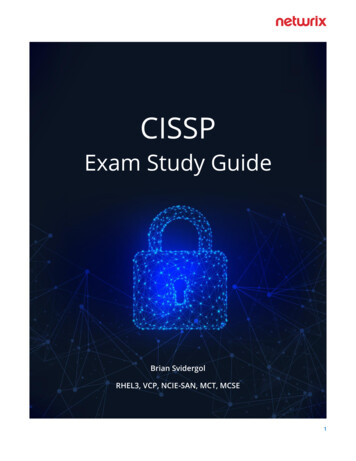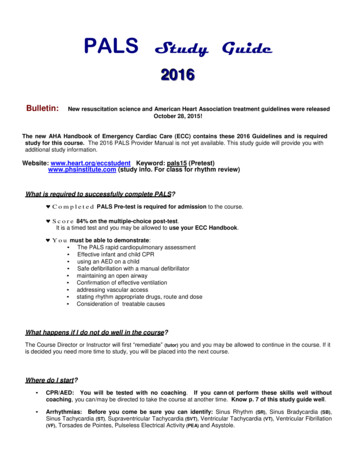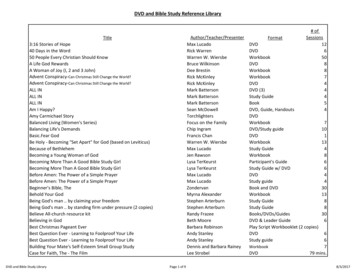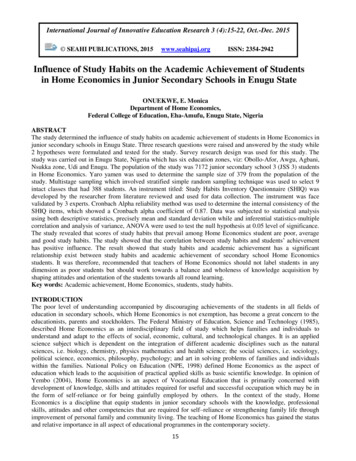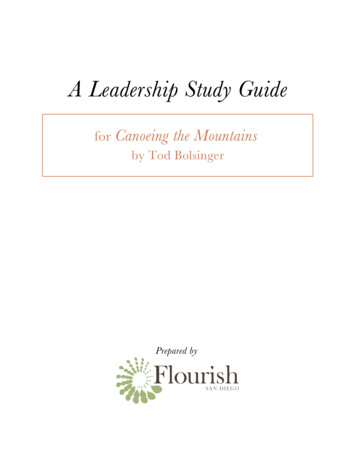
Transcription
CAN OEIN G T HE M OU N T AINS ST U DY GU IDEA N INT RO D U CT IO N F RO M T HE F L O U RIS H S A N D IEGO T EA MThe Church in Uncharted Territory“Seminary Didn’t Prepare Me For This!”This is not only the cry of many church leaders today, it’s also the title of chapter one of Canoeing theMountains by Tod Bolsinger.The early twenty-first century is a far cry from the mid-twentieth century, especially as it relates tothe church. In 1950, the church was at the center of society. It was a time in which “if a man didn’tcome to church on Sunday, his boss asked him about it at work on Monday.”1Today, the church is no longer at the center of society. Rather, the church is simply one of manyoptions—religious, social, and cultural—available to people today. Not only do far fewer peopleengage in church these days, when they do it’s less frequent.What can the church do about this new reality?Tod Bolsinger uses Lewis and Clark as an apt metaphor for our time. In 1804, Merriwether Lewisand William Clark set out to find a water route to the Pacific Ocean. They travelled the MissouriRiver to its source, expecting to find another river they could calmly canoe to the Pacific Ocean.What they found was the Rocky Mountains.Lewis and Clark could have turned around and said, “We didn’t prepare for this. Let’s go back.”But they didn’t. They set off on a journey they hadn’t expected. They had to set their canoeing skillsaside for the moment and learn along the way (relying on friends like Sacagawea) to navigate themountains.It was uncharted territory for Lewis and Clark. Likewise, the church today finds itself in unchartedterritory. What should the church do? Should we give up? Turn back? Try to get back to the “glorydays”?Or Perhaps we should face this uncharted territory with resolve, trusting that God is alreadyahead of us. Perhaps we should look at the reality of our circumstances and ask, “What can we learnhere? How might God want to shape us in this new place? Does God want to expand ourimagination for who we are called to be today?”Using the Study GuideThis study guide is designed to do two things:1. Facilitate deep reflection for you and your team on the concepts presented in the book.1Bolsinger, Tod. Canoeing the Mountains: Christian Leadership in Uncharted Territory, p. 11.1
2. Help your leaders begin the process of transformational leadership by engaging in teamexercises.Each chapter is divided into three parts: key points from the chapter, questions for discussion, andexercises to help you dig deeper. Don’t feel like you need to ask every question or complete everyexercise. Be sensitive to your team.But it is recommended that you do at least one of the exercises in each chapter of the study guide.This will help you get the most out of both the book and the study guideA Word About the 2x2 MatrixYou will notice that several chapters invite you and your team to create a 2x2 (two-by-two) matrixas one of the exercises. What does that mean?We human beings tend to see issues on a spectrum. For instance, we might see a continuum withliberal/progressive on one end and conservative/evangelical on the other end. Or perhapstraditional on one end and contemporary on the other.The problem with seeing issues in a binary way is that it limits our creativity. We end up with verysimplistic solutions to problems that we understand simplistically. We try to decide if we should be“this” or “that” without digging more deeply into more creative possibilities.A 2x2 matrix is a problem-solving tool that is designed to help lead a person or team into a deeperexploration of an issue. It is meant to help one get beyond either/or thinking and into both/andthinking. For instance, rather than saying our church must be either incarnational or attractional, a2x2 would help uncover what it might look like to be both incarnational and attractional.A 2x2 for this question would look like this:2
Team members would together fill in the boxes. What would a church look like that is neitherincarnational nor attractional (probably not very good!)? What if the church only emphasized beingincarnational? What if it was only attractional? And what if both qualities were exhibited?Use the 2x2 exercises to explore possibilities for your congregation that you may have never beforeconsidered!For more information about the 2x2 Matrix, see: The Power of the 2x2 Matrix by Alex Lowy and Phil Hood “The 2 2 Matrix: Discover Ministry Possibilities You’ve Never Considered”from the Flourish San Diego ed/Here We Go!The world has changed. The church is in uncharted territory. Meanwhile, church leaders look atone another and say, “Seminary didn’t prepare me for this!”As you work through Canoeing the Mountains and this study guide, may you be challenged, may you beencouraged, and may you find yourself transformed into the kind of leader who, with fear andtrembling, is willing to step courageously into the uncharted territory into which God is calling us.Blessings on your journey.3
Further InformationDr. Tod Bolsinger is the Vice President of Formation and Vocation at Fuller Theological Seminary(www.fuller.edu).If you’d like to order a copy of Canoeing the Mountains: Christian Leadership in Uncharted Territory, you cando so hristian-LeadershipUncharted/dp/0830841261/ref sr 1 1?ie UTF8&qid 1490726409&sr 81&keywords canoeing the mountainsNote: This “Amazon Smile” link yields a small donation to Flourish San Diego.You can also check out Tod’s blog here:http://bolsinger.blogs.comFor more information about Flourish San Diego, please visit us at:http://www.flourishsandiego.org4
CAN OEIN G T HE M OU N T AINS ST U DY GU IDECHA P T ER 1: “ S EM INA RY D ID N’ T P REP A RE M E F O R T HIS ”Key IdeaThe Church today finds itself in unfamiliar territory.Main Points1. There was a time when churches functioned primarily as vendors of religious goods and services.All a pastor needed to do was provide for Christian education, lead Christian worship services,and offer Christian counsel and support.2. People today are not particularly interested in receiving religious goods and services. This makesthe church seem essentially obsolete.3. The church is faced with an adaptive challenge — a challenge that goes beyond the technicalsolutions of resident experts or best practices, or even the organization’s current knowledge.4. Leadership is key as the church faces this uncharted territory.a. Leadership is essential. But leadership is not about titles or authority. It is about a way ofbeing that “[mobilizes] people to tackle tough challenges and thrive.”1 Leadership isabout personal and corporate transformation.b. Leadership is expressed in behaviors. Real leaders do not blame anyone or anything.They look to what they themselves can do — how they can act — differently.c. Leadership is developed. Any person who is willing to take responsibility, convene agroup to work on a tough problem and persist in the face of resistance is a leader.Leadership is learned in the doing and by reflecting on the doing.5. The church is at a crossroads. This moment requires those in positions of authority to embracean adventure-or-die mindset, and find the courage and develop the capacity for a new day.Questions1. What encourages you in this chapter? What gives you hope?2. What challenges you in this chapter? What increases your anxiety? What sounds difficult?3. In what ways have you seen your church serve as a vendor of religious goods and services? Whyis this way of being church no longer adequate?4. Which of the three leadership qualities listed above resonates with you most? Why?5. What kind of leadership is required for the unfamiliar territory — that is, the adaptive challenge— the church is facing today?Heifetz, Ronald A., Marty Linsky, and Alexander Grashow, The Practice of Adaptive Leadership: Tools and Tactics for Changing Your Organization and theWorld, Kindle ed., loc. 4894-97.15
Chapter 1 Exercises1. It’s not that providing teaching, liturgy, and pastoral care are no longer important, but they nolonger seem to be sufficient.a. Divide your group into two teams. One team will come up with a list of reasons whythese three tasks are (or ought to be) the primary task of the church. The other team willlist the reasons these tasks are insufficient to the work of the church.b. After a few minutes of list-making, stage a debate in which each team makes the case fortheir position.c. Did one of the teams “win” the debate? Did anyone change their mind about anything?Did anyone become more secure in their position? How might understanding the otherposition help when it comes to leading the church in uncharted territory?Leader’s note: The point here is to help your group see why some people may want to hold on to the old, reliable practices of thechurch. This may also help those who do hold on to old practices begin to see why they are no longer sufficient.2. Compare the best and worst leaders you’ve known.a. Think of the best leader you’ve ever experienced. Share what qualities made that personsuch an effective leader.b. Think of the worst leader you’ve ever experienced (not someone in the room!). Sharewhat qualities made that person an ineffective leader.c. Did passing blame or taking responsibility play a role in their level of effectiveness?Leader’s note: One of the themes of Canoeing the Mountains is that leaders need to take responsibility for their ownbehavior in leading the church. This exercise is meant to help people see that the best leaders don’t blame other people orcircumstances; they take responsibility and adjust their own behavior in order to address challenges.3. Create a 2x2 matrix using the categories of traditional/contemporary, outreachoriented/fellowship-oriented, and/or quality of worship service/quality of pastoral care.a. What does it look like, for instance, when your church’s focus is low in outreachorientation and low in fellowship orientation; low in outreach orientation and high infellowship orientation; high in outreach orientation and low in fellowship orientation;high in outreach orientation and high in fellowship orientation?b. Are there other 2x2’s you can come up with?Leader’s note: Churches often think of traditional and contemporary as being at opposite ends of a spectrum (often with“blended” somewhere in the middle). The same goes for categories like outreach-oriented vs. fellowship-oriented, and quality ofworship service vs. quality of pastoral care. This exercise is important because it can help us recognize that these things are notnecessarily at opposite ends of a spectrum. Perhaps we can live into both at the same time. This will, of course, requireimagination and a willingness to step into uncharted territory.6
CAN OEIN G T HE M OU N T AINS ST U DY GU IDECHA P T ER 2: “ A D VENT U RE O R D IE”Key IdeaThe way forward for the church is not by working harder at what we already do.The church needs to strike into uncharted territory with a new imagination.Main Points1. The world has become VUCA: volatile, uncertain, complex and ambiguous. This world willrequire all leaders to learn new skills.2. The mission field is no longer far away on another continent. In the 1970’s, Lesslie Newbiginsaid, “England is a pagan society and the development of a truly missionary encounter with thisvery tough form of paganism is the greatest intellectual and practical task facing the Church.”13. Leadership and leadership development must be dramatically different than it was duringChristendom.4. The answer to finding our way through uncharted territory is not to try harder but to start anew adventure — an adventure that requires adaptive capacity.Questions1. What encourages you in this chapter? What gives you hope?2. What challenges you in this chapter? What increases your anxiety? What sounds difficult?3. Do you agree with Newbigin’s statement that our world now consists of a new form ofpaganism? How have you seen this “very tough form of paganism”?4. What leadership practices in the church might no longer apply in this new world we findourselves in?5. How have you seen churches “try harder” at the things they already do in order to address thisnew culture?6. On a scale of 1-10 (1 not at all ready, 10 totally ready), how ready is your church to“adventure or die”?1Newbigin, Lesslie. Unfinished Agenda, 2nd ed., p. 236.7
Chapter 2 Exercises1. Make four columns on a sheet of paper.a. At the top of the first column, write “Volatile.” At the top of the second, write“Uncertain.” Then write “Complex” at the top of the third column, and “Ambiguous”at the top of the fourth.b. In each column list the ways you have observed the world becoming more volatile,uncertain, complex, and ambiguous.c. Then discuss the degree to which the church is prepared to deal with these issues.Leader’s note: It is important for people to understand the reality of our situation. This exercise is designed to help people cometo an awareness that the church is not prepared for the multitude of challenges we see in the world today.2. If we think of adventuring as being on a spectrum, we might put “adventure” on one end of thespectrum and “safety” on the other end. But let’s think of these two poles as a 2x2 matrix.a. Create a 2x2 with “adventure” on one axis and “safety” on the other end.b. What would it look like to be: low adventure, low safety low adventure, high safety high adventure, low safety high adventure, high safetyLeader’s note: Lots of people expect their church to be a “safe place.” They like the familiarity of their church’s facilities,programs, practices, and worship services. These folks aren’t interested in adventure. Other folks just want to shake everythingup and do nothing but adventure. Both have their pros and cons. Use this exercise to discover the value of both adventure andsafety, as well as what it might look like if your church were to pursue both qualities.8
CAN OEIN G T HE M OU N T AINS ST U DY GU IDECHA P T ER 3: “ A L EA D ERS HIP M O D EL F O R U NCHA RT ED T ERRIT O RY ”Key IdeaLeadership is energizing a community of people toward their own transformationin order to accomplish a shared mission in the face of a changing world.Main Points1. Leadership is about the transformation of a congregation so that they, collectively, can fulfill themission they, corporately, have been given.2. Leadership for a people on a mission into a new, rapidly changing world requires more thanproclamation. It requires new actions, new ways of functioning and, therefore, new learning.3. Technical problems are those where the solutions are available to and “within the repertoire” ofthe community.4. Adaptive challenges are those that “cannot be solved with one’s existing knowledge and skills,requiring people to make a shift in their values, expectations, attitudes, or habits of behaviour.”15. The transformational leadership model consists of: technical competence, relational congruence,and adaptive capacity.6. Leadership into uncharted territory requires and results in transformation of the wholeorganization, starting with the leaders.Questions1. What encourages you in this chapter? What gives you hope?2. What challenges you in this chapter? What increases your anxiety? What sounds difficult?3. What is the difference between a technical problem and an adaptive challenge?4. Why is it so important for church leaders to recognize that leadership is connected totransformation of a community? What happens if the church is not transformed?5. Why is it important for the leaders to be transformed first?1Heifetz, Ronald A. Leadership Without Easy Answers, p. 18.9
Chapter 3 Exercises1. Make a list of technical problems your church has faced in recent years (e.g., furnace broke, notenough parking, under budget). How did your church address each of these problems?Leader’s note: This will not be too difficult for the group members to do. Most problems that churches have faced over the decadesand even centuries will be technical problems.2. Name one or two adaptive challenges (e.g., changing neighborhood demographics, churchmembers attending with less frequency). How has your church tried to address these challenges?Leader’s note: It is important for people to understand the difference between technical problems and adaptive challenges. You mayhave to help group members think through possible adaptive challenges.10
CAN OEIN G T HE M OU N T AINS ST U DY GU IDECHA P T ER 4: “ CO M P ET ENCE A ND CRED IB IL IT Y ”Key IdeaThe first thing a transformational leader needs is competencein regard to what the organization already does.Main Points1. Stewardship precedes leadership. Biblically, stewardship is about faithfully protecting andpreserving what is most important, about growing and developing the potential of everythingand everyone under one’s care.2. Usually before a community of faith will even consider undergoing costly change, there must bea sense that leadership is doing everything within their power and their job description to be aseffective as possible.3. There are three basic tasks that leaders must exercise with technical competence before theyhave the credibility to go off the map into uncharted territory.a. Competent stewardship of Scriptures and tradition.i. If shared values are not “protected and passed down” then the organizationceases to be.ii. For pastors who want to lead a congregation in change the most important thingto remember is that the first step is getting clear on what will never change.b. Competent stewardship of souls and communities.i. Before we can lead our people into uncharted territory, they have to believe thatwe will spiritually protect and personally care for them along the way.c. Competent stewardship of teams and tasks.i. Pastors must have the ability to competently manage the organization orinstitution given to our charge.4. Be willing to fail quickly in order to learn. But we must still be competent. “We can fail, but wecan’t suck.”Questions1. What encourages you in this chapter? What gives you hope?2. What challenges you in this chapter? What increases your anxiety? What sounds difficult?3. What are some skills pastors and other ministry leaders must be competent in?4. Why is it so important to be competent in the “technical” aspects of ministry before moving intotransformational leadership?11
5. What’s the risk of taking on adaptive challenges before conveying competence in the technicalareas of ministry?6. How does self-awareness contribute to a leader’s level and quality of competence? For example,what if a leader falsely believes they are competent in one area of ministry, while everyone elserecognizes that their true competence is in a different area? How might that leader grow in selfawareness?Chapter 4 Exercises1. Make a list of all the technical competencies a church requires. Think of all the areas ofministry—worship, children and youth, administrative, facilities, etc.a. On a scale of 1-10, how is your church doing in each of these areas?b. Are there any areas where your church needs to become more competent (keeping inmind that you don’t have to be perfect, but you can’t “suck”)?Leader’s note: This is an opportunity to acknowledge the technical competencies required for leading and running a church. Theseare important. And perhaps this exercise will help your team verbalize an area that is deficient in competence.2. Sometimes we think of our technical responsibilities as being in conflict with our adaptivechallenges.a. Identify some seemingly conflicting technical and adaptive issues (e.g., worship style vs.changing culture, programs for the elderly vs. a younger community, etc.).b. Create a 2x2 to help you discover new possibilities that may include both.Leader’s note: Both Canoeing the Mountains and this study guide will emphasize the importance of creativity andexperimenting. Let this exercise be an exercise in creativity. You don’t necessarily need to act on what you learn (but maybe youwill!). The important thing is to begin to be more creative in your thinking.12
CAN OEIN G T HE M OU N T AINS ST U DY GU IDECHA P T ER 5: “ P REP A RING F O R T HE U NK NO W N”Key IdeaAlong with establishing credibility the leader must builda shared corporate culture of deep trust.Main Points1. Even if we agree that we are in an adapt-or-die moment, the urgency of the situation is not enough.a. When given that particular choice (adapt or die), 90% choose dying.2. “Adaptive processes don’t require leadership with answers. It requires leadership that createstructures that hold people together through the very conflictive, passionate, and sometimes awful process ofaddressing questions for which there aren’t easy answers.”13. Relational congruence is the ability to be fundamentally the same person with the same values inevery relationship, in every circumstance and especially every crisis.4. Relational congruence is more than consistent behavior; it is constancy that comes from genuineaffection, warmth, and indeed love for followers and colleagues.5. Only “meaningful work together” develops the kinds of relationships that will endure intouncharted territory.6. The goal of the Christian faith is not simply to become more loving community but to be acommunity of people who participate in God’s mission to heal the world by reestablishing his loving reign“on earth as it is in heaven.”Questions1. What encourages you in this chapter? What gives you hope?2. What challenges you in this chapter? What increases your anxiety? What sounds difficult?3. What are some skills pastors and other ministry leaders must be competent in?4. Do you believe your church is in an “adapt-or-die” moment right now? Why or why not?5. Describe “relational congruence” in your own words. On a scale of 1-10, how well do yourleaders (elders, clergy, staff, etc.) exhibit relational congruence? Is there “genuine affection,warmth, and love” among your leaders?6. What kinds of “meaningful work together” have your leaders engaged in? On a scale of 1-10,how “meaningful” was that work? How “together” was that work?1Heifetz, Ronald A. “Leadership, Adaptability, Thriving,” Faith and Leadership, November 18, 2009, www.youtube.com/watch?v CSZId1VlYxc.13
Chapter 5 Exercises1. Have each team member anonymously write down on a slip of paper how much trust (on a scaleof 1-10) they believe your leadership team has. Then collect their responses and share them withthe group. Reflect together on what the responses mean for your group. Do they truly reflect theamount of trust your group shares? What kinds of things could your team do to build trust?Leader’s note: The first step to building trust is to diagnose the current level of trust. If nothing else, this is a conversation starterabout a topic that likely has not come up in the past. Use this conversation to help your team get a sense of where they are and wherethey need to be in terms of trust.2. In order for a team to succeed at adaptive change, there must be trust. For there to be trust,team members must know one another’s stories. Take some time to share some or all of thesestories with each other.a. Start with easy-to-share stories:i. Tell us about the kinds of things you love to do. What hobbies do you have?What kinds of vacations do you like to take? What do you love to do on yourday off?ii. Where did you grow up? How long did you live there? Did you live in one placeor move around a lot? Describe your hometown?iii. Tell us about your best friend growing up. What was he or she like? What kindsof things did you do together? Were you “good” or were you “mischievous”when you were together? Share one story about you and your best friend.b. Then share deeper stories, which will require more vulnerability:i. How did you come to faith in Jesus? Were you a child or an adult? Was itthrough your family or someone else? Was it a slow process or a fast process?ii. Share one story of a difficult time in your life. What were the circumstances?How did it affect your relationship with God? How did that experience shapeyou as a person?Leader’s note: Building trust is critical for taking your team on a journey of adaptive transformation. But building trust is not easy.Some members of your team will have a difficult time opening up. Most likely, they will be men. Building trust requires a finebalance between not pushing someone to share and encouraging them to share. A leader’s job is to turn up the heat, but not so hot thatpeople get burned. If there is someone on your team who simply refuses to open up, thus making trust, and, thereby, adaptivetransformation, impossible, your team may have to consider whether or not to ask that person step down from your team.14
CAN OEIN G T HE M OU N T AINS ST U DY GU IDECHA P T ER 6: “ EA T ING S T RA T EGY F O R B REA K F A S T ”Key IdeaThe most critical attribute a congregation must have to thrivein uncharted territory is a healthy organizational culture.Main Points1. Culture is the combination of “the language we live in, the artifacts that we make use of, the ritualswe engage in, our approach to ethics, the institutions we are a part of and the narratives we inhabit[that] have the power to shape our lives profoundly.”12. Organizational culture is the “group norms of behavior and the underlying shared values that helpkeep those norms in place.”2 It is “the way we do things around here.”3. Creating healthy culture with the capacity to experiment, innovate, take risks and adapt is one ofthe primary preparatory tasks of a leader.4. A healthy culture is aligned, cohesive and clear. It is a culture where there is “minimal politics andconfusion, high degrees of morale and productivity, and very low turnover among goodemployees.” 35. Organizational health is among the most important qualities of a successful organization.6. Three critical elements are necessary in a leader’s own functioning for contributing to a healthyorganizational culture:a. Clarity: An organization’s values must be, not only clear, but also shared across theorganization.b. Embodiment: The organization’s values must be lived out in terms of the leader’s andpeople’s behavior.c. Love: Love drives us to hold on to what is dear and life-giving, and it is because of lovethat we are willing to change.Questions1. What encourages you in this chapter? What gives you hope?2. What challenges you in this chapter? What increases your anxiety? What sounds difficult?3. Describe, in your own words, what organizational culture is.4. What does the expression, “culture eats strategy for breakfast,” mean?Woodward, J.R. Creating a Missional Culture: Equipping the Church for the Sake of the World, p. 20.Kotter, John. “The Key to Changing Organizational Culture,” Forbes, September 27, 2012.3 Lencioni, Patrick M. The Advantage: Why Organizational Health Trumps Everything Else in Business, p. 5.1215
5. What are some key characteristics of your church’s organizational culture? What kind oflanguage do you use to describe your church? What kinds of rituals or processes are importantto your church (not only in worship services, but in all areas of how your church operates)?What are some important stories in your church’s history that capture who your church is?6. Why is organizational health so important for transformational leadership?Chapter 6 Exercises1. On a scale of 0-10 (0 completely unhealthy, 10 total health full of trust, clarity, love,embodiment of values, etc.), how would you rate the health of your church’s culture?a. Have each group member anonymously write down on a slip of paper how healthy theybelieve your church’s culture is. Then collect their responses and share them with thegroup.b. Reflect together on what the responses mean. Do you see any common themes? Whatare some first steps your church might take toward developing a healthier organizationalculture?Leader’s note: This exercise will not definitively answer the question, “How healthy is your church?” But it will give you a startingpoint for conversation and help your team begin to see areas of health and unhealthy within your church’s culture. Don’t let theresponses make you defensive. Invite openness and safety.2. Sometimes churches will think of love and clarity as being on opposite ends of a spectrum. Forinstance, if we’re truly loving we won’t force people to live out the values we profess. Or if wehold people accountable to living out certain values, we may risk being less loving.a. Create a 2x2 matrix with love on the vertical axis and clarity on the horizontal axis.b. What would it look like to have low love and low clarity; low love and high clarity; highlove and low clarity; and high love and high clarity?Leader’s note: This exercise will help your people see that clarity and love are not exclusive of one another. They may, in fact,discover that love and clarity in an organization are not only beneficial, but even amplify one another.16
CAN OEIN G T HE M OU N T AINS ST U DY GU IDECHA P T ER 7: “ NA VIGA T ING T HE ‘ GEO GRA P HY O F REA L IT Y ’ ”Key IdeaWhen our old maps fail us, something within us dies.Replacing our paradigms is both deeply painful and absolutely critical.Main Points1. When a mental model dies, a painful paradigm shift takes place within us. It is disorienting andanxiety making. It’s as if the world as we know it ceases to exist.2. Adaptive leadership helps people become aware of the gap between our aspired values and ouractions, between our values and the reality we face.3. Adaptive leadership sheds light on the competing values that keep a group stuck in the status quo.Competing values (e.g., caring for longtime members vs. reaching out to the unchurched, givingpay raises vs. bringing on a new hire, assuring control and un
Further Information Dr. Tod Bolsinger is the Vice President of Formation and Vocation at Fuller Theological Seminary (www.fuller.edu). If you’d like to order a copy of Canoeing the Mountains: Christi





